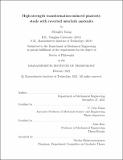High-strength transformation-induced plasticity steels with reverted interlath austenite
Author(s)
Jiang, Menglei
DownloadThesis PDF (47.64Mb)
Advisor
Tasan, C. Cem
Terms of use
Metadata
Show full item recordAbstract
The interlath austenite formed by reversion process increases the ductility of the martensitic steels. However, the reversion process requires high annealing temperatures and long annealing times, which lead to high energy cost and unwanted softening. In this thesis, two methods are applied to increase the reversion kinetics: (i) changing the reversion mechanism from diffusive to displacive; (ii) changing the alloy composition to promote diffusive transformation. To promote local displacive austenite reversion, the enrichment of austenite stabilizer at the martensite boundaries is introduced before reversion. To promote the diffusional transformation process, computational alloy design is applied, where the effects of alloying elements on kinetics of austenite reversion and martensite softening are evaluated. The phase transformation kinetics and the microstructural evolution during (displacive and diffusive) austenite reversion are characterized by carrying out differential scanning calorimetry measurements and multi-probe microstructure analysis, and its mechanical impacts are discussed. In method (i), the reversion kinetics increases significantly by promoting displacive transformation. The defect development during displacive reversion can help increase the overall strain hardening capacity of the alloy, which in turn increases the accumulative uniform elongation, and the formability. In method (ii), the diffusive austenite reversion is achieved before the overaging of the martensite, which significantly improves the ductility of the designed martensitic steel without softening. These results suggest that overaging and softening of the martensite (rather than the formation of the austenite) are the major contributions to the softening phenomenon. Thus, the strength of the transformation induced plasticity steels can be improved by increasing the kinetics of the interlath austenite reversion process.
Date issued
2022-02Department
Massachusetts Institute of Technology. Department of Mechanical EngineeringPublisher
Massachusetts Institute of Technology